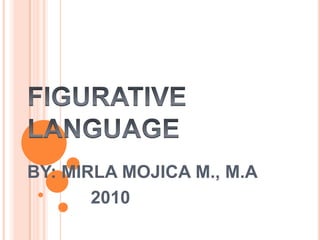
Figurative Language
- 1. FIGURATIVE LANGUAGEBY: MIRLA MOJICA M., M.A 2010
- 2. WHAT IS FIGURATIVE LANGUAGE? Figurative language is the language that uses words or expressions with a meaning that is different from the literal interpretation. When a writer uses literal language, he or she is simply stating the facts as they are.
- 3. Figurative language, in comparison, uses exaggerations or alterations to make a particular linguistic point. Figurative language is very common in poetry, but is also used in prose and nonfiction writing as well. There are many types of figurative language
- 4. SIMILE A simile is a comparison that often uses the words likeor as Example: “Nancy runs as fast as the wind.”
- 5. METAPHOR A metaphor is a comparison made between things which are essentially not alike. It is similar to a simile, but does not use like or as. EXAMPLE: “I am a rainbow.”
- 6. PERSONIFICATION When something that is not human is given human-like qualities, this is known as personification. EXAMPLE. “ She did not realize that opportunity was knocking at her door”.
- 7. HYPERBOLE Exaggerating, often in a humorous way, to make a particular point . EXAMPLE: “I'm so hungry, I could eat a horse right now”.
- 8. ONOMATOPOEIA When you name an action by imitating the sound associated with it, this is known as onomatopoeia. EXAMPLE: "Bang! went the pistol,Crash! went the windowOuch! went the son of a gun.